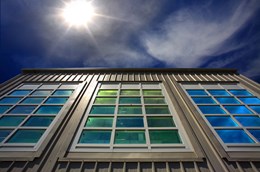-

The U.S. Department of Energy’s Advanced Research Projects Agency-Energy (ARPA-E) today announced up to $30 million in funding for a new program focused on improving the energy efficiency of commercial and residential buildings.
-

Croatia is one of the recognized leaders in South-East Europe in the field of energy management, monitoring and assessment of the energy consumption, which are important aspects of the rational use of energy in buildings. That is why Croatia was chosen as the country for a study tour of officials and experts of Turkmenistan on energy conservation and management in buildings.
-

For the purpose of supporting agencies and organizations to access policies and technology solutions to economical and efficient use of energy, gaining economic and environmental benefits, Department of Science and Technology of Hai Phong held a seminar on “Energy-saving solutions for buildings”.
-

According to Hanoi Energy Conservation Center (Hanoi ECC), a unit as Savico Megamall Trade Center, thanks to the overall application of economical solutions, can save approximately 524,000 kWh in 2014, equivalent up to VND 1.36 billion.
-

London Mayor Boris Johnson has launched a tool for public sector organisations to make homes more energy efficient.
-

Representatives of the Ministry of Construction reveal that buildings consume more than 30% of total energy consumption in the fast growing economy. Thus improving the energy efficiency for the new construction is an urgent requirement.
-

The Clean Energy Program of USAID Vietnam has coordinated with the Hai Phong Department of Construction to organize a training course "Promoting the construction and operation of buildings in energy saving and efficiency (Standard QC: 09/2013 ), High-performance and green Buildings in Vietnam."
-

Under the guidance of the Ministry of Industry and Trade, Ho Chi Minh Energy Conservation Center continues the competition, "Energy-efficient Buildings" for 2016. The competition is meant for the following types: Building / Resort, Hospital, Office , School / Library, Mall / Super Market ... nationwide.
-

A project that is expected to help save around 50% of energy used to heat multi-storey buildings in Romania has bagged a loan from the EU bank.
-

Nearly 40 % of energy consumption in the EU goes to heating, cooling and lighting buildings. Their energy demands account for large amounts of carbon dioxide emissions.
-

Economical and efficient use of energy in buildings and construction, the encouragement of greening construction materials are two out of five main tasks of the construction industry under the National Action Plan for green growth construction.
-

Mitsubishi Chemical Holdings Corporation recently introduced a material that enables the walls of buildings (and other structures) to generate electricity.
-

Jersey City officials are aiming to make city buildings more energy-efficient by implementing energy audits every three years, the city announced yesterday.
-

The findings from a survey in 300 hotels, buildings in the southern region, conducted by HCM city Center of Energy Conservation show that the top energy consuming factor is the air-conditioning system (65%), followed by hot water system, accounting for over 15% of the total energy consumption.
-

Volvo Group achieved its goal of reduced energy consumption in the U.S. Department of Energy (DOE) Better Buildings, Better Plants Challenge five years earlier than anticipated, the company announced.
-

Based on the survey findings at 300 hotels, buildings in the south conducted by the Energy Conservation Center of HCM City, the frontline consumers of energy is the air-conditioning system (65% ), followed by water heating system ranked with over 15% of the total energy consumption.
-

University of Stuttgart and Cofely Deutschland agree energy performance contracting for a term of eight and a half years. 15 buildings on Campus Stadtmitte are being modernised. Guaranteed energy cost savings of 26 %
-

A member of the World Bank Group is working with the Peruvian Government to make buildings more energy efficient.
-

Schneider Electric presented today its latest energy efficiency project for buildings, developed for Skanska’s Green Court Bucharest office building.
-

The energy required to run the center will be drawn from the highly efficient local energy grid which is powered by renewable sources such as wind, solar and hydro power. Through a combination of various energy saving techniques, excess energy produced by the facility will serve to heat buildings in the district.




















 Energy efficiency and sustainable development in textile sector
Energy efficiency and sustainable development in textile sector
 Hoa Phat saves nearly 3,500 billion dong thanks to self-generated electricity
Hoa Phat saves nearly 3,500 billion dong thanks to self-generated electricity
 Enhancing capacity to develop and implement energy efficiency policies at local level
Enhancing capacity to develop and implement energy efficiency policies at local level
 Stanley Vietnam: Targeting a 4% Reduction in Annual Energy Consumption Intensity
Stanley Vietnam: Targeting a 4% Reduction in Annual Energy Consumption Intensity
 Nghe An Industrial Enterprises Proactively Implement Energy-Saving Measures
Nghe An Industrial Enterprises Proactively Implement Energy-Saving Measures
 WEBINAR 1 - Scaling Up Energy Efficiency in Vietnam
WEBINAR 1 - Scaling Up Energy Efficiency in Vietnam
 Bosch Vietnam Plant Benefits from Investment in Energy Efficiency
Bosch Vietnam Plant Benefits from Investment in Energy Efficiency